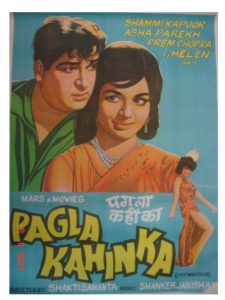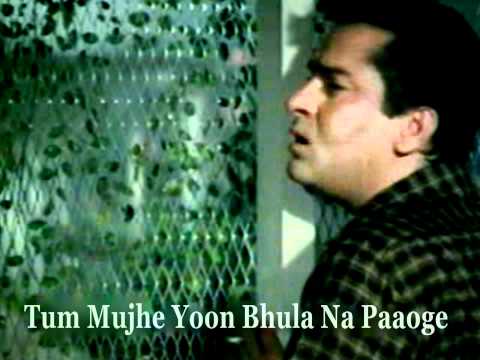Raaga Based Song of the Day: Tum mujhe youn bhula na paoge…
Raag Jhinjhoti, Tal Kaherava
This blog has a number of posts on Raaga based songs in Hindi movies titled similarly; for example: ‘The Best Raaga Based Songs in Hindi Movies – Raag Jaijaivanti’.
Whilst sharing Raaga based Hindi films songs with you, it occurred to me that ancient Indians were very innovative people in various fields including music, literature, science, maths, and astronomy. It is just that we were poor in documenting our achievements and that’s where the West scored over us.
I was fortunate to have become member of a group engaged in Vedic research and I was delighted to see the origin of all complex mathematical equations in the world as Vedic maths (not the group’s finding but that of a research team commissioned by the Government of India about two decades back).
The renewed interest in Raagas based music in our younger generation is a healthy trend to take us away from our ingrained cynicism about India (Please read: ‘The Greatness Of India And Its Decline’) and bring us closer to the ancient greatness of our country.
I shall give you regular inputs about Raaga based songs by discussing with you one song a day.
A recent visitor to our house in Shimla Hills called Whispering Winds (Please read: ‘Home Is Where The Heart Is – Kandaghat In Shimla Hills’) mentioned that Pandit Bhimsen Joshi once said that he had about 5 percent knowledge of Raagas! In quick proportionate calculations I have about 0.00001 percent (I am a former Navy officer with no institutionalised training on music)! But, I am learning and so will you.
Stay tuned!
We have to be thankful to Pandit Vishnu Narayan Bhatkhande (early 20th century) who devised the modern system of Raagas for Hindustani Classical Music (based on Thaats), which is much more easily understood than the one prevalent before that (passed only through word of mouth) based on Raagas (male), Ragini (female) and Putra (children). The earlier system has been mentioned in the holy book of the Sikhs: Sri Guru Granth Sahib on pages 1429 and 1430 (last pages). Sikhs traditionally used the Raagas in singing hymns and had bedis who went from place to place singing the Raagas.
Raag Jhinjhoti is a raag named after an apsara. Jhinjhoti is a Raag in Khamaj Thaat. In the modern Thaat system that was created by Vishnu Narayan Bhatkhande (1860–1936), a Thaat is a mode in Hindustani classical music and is a basis for classifying Raagas. Bhatkhande visited a number of gharanas (ad-hoc schools that followed guru-shishya sytem (teacher-pupil system) for passing knowledge down the generations. Interestingly, these gharanas were not open to all and sundry and most often than not a shishya had to prove that he was worthy of being taken as a shishya) (You must listen to Baiju Bawra’s ‘Man tadpat Hari darsan ko aaj‘ (Raag Malkauns, Tal Tintal) to know how a shishya had to prove his single-minded deication).
Surprisingly, the word Raaga doesn’t mean music but colour or dye or shade. But if you think of colours signifying moods, Raagas in music do exactly that. For example, if the colour yellow is the colour of love and red of passion, each one of the raagas is based on mood, time of the day and even season. An easy anology is the Hindi saying: सावन के अंधे को हरा ही हरा दिखाई देता है I You will instantly know that Sawan (Monsoon) is being used as a season, colour and mood.
According to Pandit Bhatkhande, each one of the raagas is based on one thaat (mode) or the other. Although his research with gharanas made him short-list 32 thaats, he finally pruned the list to just ten thaats on which most raagas are based. These are: Bilawal, Kalyan, Khamaj, Bhairav, Poorvi, Marwa, Kafi, Asavari, Bhairavi and Todi. And that’s why I mentioned that Jhinjhoti belongs to Khamaj Thaat.
Almost all songs in Hindi movies based on this raag have an element of self-pity in them, eg, Ghungru ki tarah bajta hi raha hoon main, Koi hamdam na raha, Mere mehboob tujhe, Mose chhal kiye jaaye, and my second most favourite Lata song: Jaa jaa re jaa balamwa from Basant Bahar.

The 1970 movie Pagla Kahin Ka was the most challenging job taken up by Shammi Kapoor. He was a mentally deranged person but as the movie progressed, one was left wondering at the sick mentality of those ostensibly sound in body and mind.
Of course the song Tum mujhe yun bhula na paoge is one of the best of Mohammad Rafi.
But today, first, I am going to do something different. I am going to give you the female version to savour its exquisite lyrics penned by Hasrat Jaipuri and its most beautiful composition in this Raag and Tal Kaherava by Shankar Jaikishan.
Please enjoy Lata Mangeshkar sing for Asha Parekh: Tum mujhe youn bhula na paoge…
jab kabhi bhi sunoge geet mere
sang sang tum bhi gungunaoge
tum mujhe yu bhula na paoge
ha tum mujhe yu bhula na paoge
jab kabhi bhi sunoge geet mere
sang sang tum bhi gungunaoge
ha tum mujhe yu bhula na paoge
ho tum mujhe yu
biti baato ka kuch khyaal karo
kuch to bolo kuch hamse baat karo
biti baato ka kuch khyaal karo
kuch to bolo kuch hamse baat karo
raaz-e-dil mai tumhe bata dungi
mai tumhari hu maan jaoge
ha tum mujhe yu bhula na paoge
ha tum mujhe yu
meri khamosiyo ko samjho tum
jindagi yaad me gujari hai
meri khamosiyo ko samjho tum
jindagi yaad me gujari hai
mai miti hu tumhari chahat me
or kitna mujhe mitaoge
ha tum mujhe yu bhula na paoge
ha tum mujhe yu
dil hi dil me tum hi se pyar kiya
apne jiwan ko bhi nisar kiya
dil hi dil me tum hi se pyar kiya
apne jiwan ko bhi nisar kiya
kaun tadpa tumhari raaho me
jab ye sochoge jaan jaoge
ha tum mujhe yu bhula na paoge
jab kabhi bhi sunoge geet mere
sang sang tum bhi gungunaoge
ha tum mujhe yu bhula na paoge
ha tum mujhe yu
Lets now listen to Mohammad Rafi version:
Tum mujhe yU.N bhulaa naa paaoge
haa.N tum mujhe yU.N bhulaa naa paaoge
jab kabhii bhii sunoge giit mere
sa.ng sa.ng tum bhii gunagunAoge
haa.N tum mujhe yU.N bhulaa naa paaoge
ho tum mujhe yU.N …
(vo bahaare.n vo chaa.ndanii raate.n
hamane kii thii jo pyAr kii baate.n ) – 2
un nazaaro.n kii yaad aaegii
jab khayaalo.n me.n mujhako laaoge
haa.N tum mujhe yU.N bhulaa naa paaoge
ho tum mujhe yU.N …
(mere haatho.n me.n teraa cheharaa thaa
jaise koI gulaab hotaa hai ) – 2
aur sahaaraa liyaa thaa baaho.n kaa
vo shaam kis tarah bhulaaoge
haa.N tum mujhe yU.N bhulaa naa paaoge
ho tum mujhe yU.N …
(mujhako dekhe binaa qaraar naa thaa
ek aisaa bhii daur guzaraa hai ) – 2
jhUTh maanU.N to pUchhalo dil se
mai.n kahU.ngaa to rUTh jaaoge
haa.N tum mujhe yU.n bhulaa naa paaoge
jab kabhii bhii …
Normally, it is a done thing to start learning about Raagas with Raag Yaman or Kalyan, the first of the Raagas that most students of classical music learn. Hence, if my starting with Raag Jhinjhoti has left you wondering, let me explain:
- Jhinjhoti is the Raag of my most favourite song: Mere mehboob tujhe meri mohabbat ki kasam (Raag Jhinjhoti, Tal Dadra) put together by Shakeel Badayuni (Lyricist), Naushad (Composer) and Mohammad Rafi (Singer). I am partial to it as much as anyone in love.
- Shankar Jaikishan are my most favourite music duo.
- Chand and/or Chandini Raatein is my most favourite songs theme.
Anyway, our learning together is going to be an everyday affair and it doesn’t matter where we start from.
I hope I have whetted your appetite to learn more about Raagas, Thaats, Tals, Swar and the like.
As I said: Stay tuned!

Your quest for learning is most remarkable , dear Ravi .God bless
Thank you, Sir. I am always keen to learn newer subjects than to stick with just one subject throughout my life – maritime strategy! Regards.